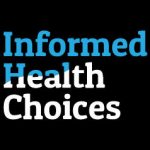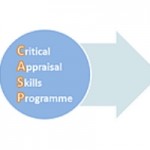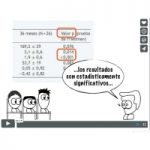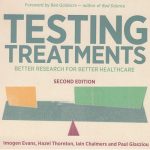
Linguistic strategies for improving informed consent in clinical trials among low health literacy patients
Evidence-based guidance on how to improve informed consent processes for patients being invited to participate in clinical research.
| 0 Comments | Evaluated
Informed Health Choices Podcasts
Each episode includes a short story with an example of a treatment claim and a simple explanation of a Key Concept used to assess that claim
| 1 Comment | Evaluated
Informed Health Choices Primary School Resources
A textbook and a teachers’ guide for 10 to 12-year-olds. The textbook includes a comic, exercises and classroom activities.
| 0 Comments | Evaluated
Ebm@school – a curriculum of critical health literacy for secondary school students
A curriculum based on the concept of evidence-based medicine, which consists of six modules.
| 0 Comments | Evaluated
Confidence Intervals – CASP
The p-value gives no direct indication of how large or important the estimated effect size is. So, confidence intervals are often preferred.
| 0 Comments | Evaluated
Know Your Chances
This book has been shown in two randomized trials to improve peoples' understanding of risk in the context of health care choices.
| 0 Comments | Evaluated
Philosophy for Children (P4C)
P4C promotes high-quality classroom dialogue in response to children’s own questions about shared stories, films and other stimuli.
| 0 Comments | Evaluated
Thinking, talking, doing science
An experimental educational intervention in teaching science at primary schools.
| 0 Comments | Evaluated
Evidence for everyday health choices
A 17-min slide cast by Lynda Ware, on the history of EBM, what Cochrane is, and how to understand the real evidence behind the headlines.
| 0 Comments
Sunn Skepsis
Denne portalen er ment å gi deg som pasient råd om kvalitetskriterier for helseinformasjon og tilgang til forskningsbasert informasjon.
| 0 Comments
Dancing statistics: Explaining variance
A 5-minute film demonstrating the statistical concept of variance through dance.
| 0 Comments
Dancing statistics: sampling & standard error
A 5-minute film demonstrating the statistical concept of sampling and standard error through dance.
| 0 Comments
Don’t jump to conclusions, #Ask for Evidence
An introduction to the ‘Ask for Evidence’ initiative launched by ‘Sense about Science’ in 2016.
| 0 Comments

How can you know if the spoon works?
Short, small group exercise on how to design a fair comparison using the "claim" that a spoon helps retain the bubbles in champagne.
| 0 Comments
English National Curriculum vs Key Concepts – Key Stage 3
A linked spreadsheet showing how the Key Concepts map to the Science National Curriculum in England at Key Stage 3 (ages 11-14).
| 0 Comments
Calling Bullshit Syllabus
Carl Bergstrom's and Jevin West's nice syllabus for 'Calling Bullshit'.
| 0 Comments
Tom Hanks and Type 2 Diabetes
A 50-minute illustrated talk by James McCormack prompted by Tom Hanks’ announcement that he had been diagnosed with Type 2 diabetes.
| 0 Comments
‘Tricks to help you get the result you want from your study (S4BE)
Inspired by a chapter in Ben Goldacre’s ‘Bad Science’, medical student Sam Marks shows you how to fiddle research results.
| 0 Comments
Reporting the findings: Absolute vs relative risk
Absolute Differences between the effects of two treatments matter more to most people than Relative Differences.
| 0 Comments
It’s just a phase
A resource explaining the differences between different trial phases.
| 0 Comments
Strictly Cochrane: a quickstep around research and systematic reviews
An interactive resource explaining how systematic and non-systematic reviews differ, and the importance of keeping reviews up to date.
| 0 Comments
The Princess and the p-value
An interactive resource introducing reporting and interpretation of statistics in controlled trials.
| 0 Comments

Teach Yourself Cochrane
Tells the story behind Cochrane and the challenges finding good quality evidence to produce reliable systematic reviews.
| 3 Comments
Explaining the mission of the AllTrials Campaign (TED talk)
Half the clinical trials of medicines we use haven’t been published. Síle Lane shows how the AllTrials Campaign is addressing this scandal.
| 0 Comments
Building evidence into education
Ben Goldacre explains why appropriate infrastructure is need to do clinical trials of sufficient rigour and size to yield reliable results.
| 0 Comments
Dodgy academic PR
Ben Goldacre: 58% of all press releases by academic institutions lacked relevant cautions and caveats about the methods and results reported
| 0 Comments
Over there! An 8 mile high distraction made of posh chocolate!
Ben Goldcare illustrates strategies used by vested interests to discredit research with ‘inconvenient’ results.
| 0 Comments
Brain imaging studies report more positive findings than their numbers can support. This is fishy.
Ben Goldacre explores how twice as many positive findings as could realistically have been expected from the data reported may have occurred
| 0 Comments
What if academics were as dumb as quacks with statistics?
Ben Goldacre introduces a statistical error that appears in about half of all the published papers in academic neuroscience research.
| 0 Comments
The strange case of the magnetic wine
Ben Goldacre shows how claims for the wine-maturing effects of magnets could be assessed with 50 people in an evening.
| 0 Comments
Sampling error, the unspoken issue behind small number changes in the news
Ben Goldacre stresses the importance of taking account of “sampling variability” and confidence intervals.
| 0 Comments
The certainty of chance
Ben Goldacre reminds readers how associations may simply reflect the play of chance, and describes Deming’s illustration of this.
| 0 Comments
How myths are made
Ben Goldacre draws attention to Steven Greenberg’s forensically based illustration of citation biases.
| 0 Comments
Cherry picking is bad. At least warn us when you do it.
Ben Goldacre illustrates how biased ‘cherry picking’ and choosing from the relevant evidence can result in unreliable conclusions.
| 0 Comments
The Man Who Swallowed The Pea, and Other Tall Tales
Tamara Ingamells’ lesson plan using the claim that MMR vaccination causes autism to help teenagers understand the importance of biases.
| 0 Comments
Dragon Lesson Plan to investigate multivariate categorical data
Investigating multivariate data by sorting and organising a set of dragon cards to uncover information about the set.
| 0 Comments
Fast Stats to explain absolute risk, relative risk and Number Needed to Treat (NNT).
A 15-slide presentation on ‘Fast Stats’ to explain absolute risk, relative risk and Number Needed to Treat (NNT) prepared by PharmedOut.
| 0 Comments
Unsubstantiated and overstated claims of efficacy
A 32-slide presentation on misleading advertisements and FDA warnings prepared by PharmedOut.
| 0 Comments
Critical appraisal
University of New South Wales Medical Statistics Tutorial 4 addresses Critical Appraisal.
| 0 Comments
Probability and tests of statistical significance
University of New South Wales Medical Statistics Tutorial 6 addresses ‘Probability and tests of statistical significance’.
| 0 Comments
Bias – the biggest enemy
University of New South Wales Medical Stats Online Tutorial 5 addresses ‘Bias - the biggest enemy’.
| 0 Comments
Generation R – Pictionary research activity
GenerationR’s version of Pictionary using research concepts instead of usual game cards, allocated in different levels of difficulty.
| 0 Comments
Generation R – Clinical trials card-sorting exercise
Card-sorting exercise developed by GenerationR to familiarise children and young people with jargon terms used by clinical researchers.
| 0 Comments
Clinical Research Workshop
‘Clinical Research Workshop’ developed for young people by the Centre of the Cell.
| 0 Comments
Introduction to Evidence-Based Medicine
Bill Caley’s 26 slides with notes used as an ‘Introduction to Evidence-Based Medicine’.
| 0 Comments
2×2 tables and relative risk
A 10-min talk on ‘2x2 tables and Relative Risk’, illustrated by 14 slides, with notes.
| 0 Comments
Appraisal of evidence and interpretation of results
A 14-min talk on ‘Appraisal of the Evidence and Interpretation of the Results’, illustrated by 19 slides, with notes.
| 0 Comments
Basic principles of randomised trials, and validity
A 8-min talk on ‘Basic principles of Randomised Trials, and Validity’, illustrated by 15 slides, with notes.
| 0 Comments
Defining clinical questions
An 8-min talk on ‘Defining Clinical Questions’ illustrated by 10 slides, with notes.
| 0 Comments
A way to teach about systematic reviews
81 slides used by David Nunan (Centre for Evidence-Based Medicine, Oxford) to present ‘A way to teach about systematic reviews’.
| 0 Comments
Applying the evidence
Six key slides produced by the University of Western Australia on applying evidence in practice.
| 0 Comments
Appraising the evidence
Six key slides produced by the University of Western Australia to introduce critical appraisal.
| 0 Comments
The power of the placebo effect
Emma Bryce’s video presents information about placebo effects: treatments not supposed to have an effect but which make people feel better.
| 0 Comments
Detectives in the classroom
Five modules of materials for promoting epidemiology among high school students.
| 0 Comments
Not all scientific studies are created equally
David Schwartz dissects two types of studies that scientists use, illuminating why you should always approach claims with a critical eye.
| 1 Comment
Taking account of the play of chance
Differences in outcome events in treatment comparisons may reflect only the play of chance. Increased numbers of events reduces this problem
| 0 Comments
Quantifying uncertainty in treatment comparisons
Small studies in which few outcome events occur are usually not informative and the results are sometimes seriously misleading.
| 0 Comments
Bringing it all together for the benefit of patients and the public
Improving reports of research and up-to-date systematic reviews of reliable studies are essential foundations of effective health care.
| 0 Comments
Applying the results of trials and systematic reviews to individual patients
Paul Glasziou uses 28 slides to address ‘Applying the results of trials and systematic reviews to individual patients’.
| 0 Comments
10 Components of effective clinical epidemiology: How to get started
PDF & Podcast of 1-hr talk by Carl Heneghan (Centre for Evidence-Based Medicine, Oxford) on effective clinical epidemiology.
| 0 Comments
Making the most of the evidence in education
A pamphlet to guide people using research evidence when deliberating about educational policies.
| 0 Comments
Critical appraisal of clinical trials
Slides developed by Amanda Burls for an interactive presentation covering the most important features of well controlled trials.
| 0 Comments
Caffeine Soft Drinks affect Human Heart Rate. Lesson Plan
A lesson to illustrate how medical researchers study the effects of drugs on people.
| 0 Comments
Life saving maths: How does vaccination work?
Vaccinating a large enough proportion of children means everyone is protected, including those who can't be vaccinated.
| 0 Comments
How to work out whether bacon sandwiches are harmful
The headline said there is a 20% greater risk of getting bowel cancer if you eat bacon sandwiches! Are they right?
| 0 Comments
Explaining the unbiased creation of treatment comparison groups and blinded outcome assessment
A class were given coloured sweets and asked to design an experiment to find out whether red sweets helped children to think more quickly.
| 0 Comments
Investigating how to remove bacteria from hands
Investigate the best way to remove bacteria from your hands.
| 0 Comments
Tips for understanding Intention-to-Treat analysis
Ignoring non-compliance with assigned treatments leads to biased estimates of treatment effects. ITT analysis reduces these biases.
| 0 Comments
Tips for understanding Absolute vs. Relative Risk
Absolute Differences between the effects of two treatments matter more to most people than Relative Differences.
| 0 Comments
Applying Systematic Reviews
How useful are the results of trials in a systematic review when it comes to weighing up treatment choices for particular patients?
| 0 Comments
Systematic Reviews and Meta-analysis: Information Overload
None of us can keep up with the sheer volume of material published in medical journals each week.
| 0 Comments
Combining the Results from Clinical Trials
Chris Cates notes that emphasizing the results of patients in particular sub-groups in a trial can be misleading.
| 0 Comments
How Science Works
Definitions of terms that students have to know for 'How Science Works' and associated coursework, ISAs, etc
| 0 Comments
GenerationR – The importance of involving children and young people in research
3/3, 22-min video at the launch of GenerationR, a network of young people who advise researchers.
| 0 Comments
Generation R – The importance of medical research in children and young people
2/3, 35-min video at the launch of GenerationR, a network of young people who advise researchers.
| 0 Comments
Generation R – The need to reduce waste in clinical research involving children
1/3, 14-min video at the launch of GenerationR, a network of young people who advise researchers.
| 0 Comments
No Power, No Evidence!
This blog explains that studies need sufficient statistical power to detect a difference between groups being compared.
| 0 Comments
Beginners guide to interpreting odds ratios, confidence intervals and p values
A tutorial on interpreting odds ratios, confidence intervals and p-values, with questions to test the reader’s knowledge of each concept.
| 0 Comments
Sample Size matters even more than you think
This blog explains why adequate sample sizes are important, and discusses research showing that sample size may affect effect size.
| 0 Comments
What is it with Odds and Risk?
This blog explains odds ratios and relative risks, and provides the formulae for calculating both measures.
| 0 Comments
The Systematic Review
This blog explains what a systematic review is, the steps involved in carrying one out, and how the review should be structured.
| 0 Comments
The Mean: Simply Average?
This blog explains ‘the mean’ as a measure of average; describes how to calculate it; and flags up some caveats.
| 0 Comments
Publication Bias: An Editorial Problem?
A blog challenging the idea that publication bias mainly occurs at editorial level, after research has been submitted for publication.
| 0 Comments
The Bias of Language
Publication of research findings in a particular language may be prompted by the nature and direction of the results.
| 0 Comments
Defining Bias
This blog explains what is meant by ‘bias’ in research, focusing particularly on attrition bias and detection bias.
| 0 Comments
Data Analysis Methods
A discussion of 2 approaches to data analysis in trials - ‘As Treated’, and ‘Intention-to-Treat’ - and some of the pros and cons of each.
| 0 Comments
Defining Risk
This blog defines ‘risk’ in relation to health, and discusses some the difficulties in applying estimates of risk to a given individual.
| 0 Comments
Traditional Reviews vs. Systematic Reviews
This blog outlines 11 differences between systematic and traditional reviews, and why systematic reviews are preferable.
| 0 Comments
P Value in Plain English
Using simple terms and examples, this blog explains what p-values mean in the context of testing hypotheses in research.
| 0 Comments
Making sense of randomized trials
A description of how clinical trials are constructed and analysed to ensure they provide fair comparisons of treatments.
| 0 Comments
Randomized Control Trials
1/2, 40-min lecture on randomized trials by Dr R Ramakrishnan (Lecture 25) for the Central Coordinated Bioethics Programme in India.
| 0 Comments
Compliance with protocol and follow-up in clinical trials
Denis Black’s 10-min, downloadable, PowerPoint presentation on compliance, follow up, and intention-to-treat analysis in clinical trials.
| 0 Comments
Clinical Significance – CASP
To understand results of a trial it is important to understand the question it was asking.
| 0 Comments
Statistical Significance – CASP
In a well-conducted randomized trial, the groups being compared should differ from each other only by chance and by the treatment received.
| 0 Comments
P Values – CASP
Statistical significance is usually assessed by appeal to a p-value, a probability, which can take any value between 0 and 1 (certain).
| 0 Comments
Making sense of results – CASP
This module introduces the key concepts required to make sense of statistical information presented in research papers.
| 0 Comments

Randomised Control Trials – CASP
This module looks at the critical appraisal of randomised trials.
| 0 Comments
Common Sources of Bias
Bias (the conscious or unconscious influencing of a study and its results) can occur in different ways and renders studies less dependable.
| 0 Comments
Tamiflu: securing access to medical research data
A campaign by researchers has shown that Roche spun the research on Tamiflu to meet their commercial ends.
| 0 Comments
MMR: the facts in the case of Dr Andrew Wakefield
This 15-page cartoon explains the events surrounding the MMR controversy, and provides links to the relevant evidence.
| 5 Comments
Los intervalos de confianza en investigación
¿Para qué sirven los intervalos de confianza en los estudios de investigación?
| 0 Comments


The need to compare like-with-like in treatment comparisons
Allocation bias results when trials fail to ensure that, apart from the treatments being compared, ‘like will be compared with like'.
| 0 Comments
Why avoiding differences between treatments allocated and treatments received is important
Knowledge of which treatments have been received by which study participants can affect adherence to assigned treatments and result in bias.
| 0 Comments
The need to avoid differences in the way treatment outcomes are assessed
Biased treatment outcome assessment can result if people know which participants have received which treatments.
| 0 Comments
Avoiding biased selection from the available evidence
Systematic reviews are used to identify, evaluate and summarize all the evidence relevant to addressing a particular question.
| 0 Comments
Preparing and maintaining systematic reviews of all the relevant evidence
Unbiased, up-to-date systematic reviews of all the relevant, reliable evidence are needed to inform practice and policy.
| 0 Comments
Dealing with biased reporting of the available evidence
Biased reporting of research occurs when the direction or statistical significance of results influences how research is reported.
| 0 Comments
Using the results of up-to-date systematic reviews of research
Trustworthy evidence from research is necessary, but not sufficient, to improve the quality of health care.
| 0 Comments
Introduction to JLL Explanatory Essays
Professionals sometimes harm patients by using inadequately evaluated treatments. Research addressing uncertainties can reduce this harm.
| 0 Comments
Avoiding biased treatment comparisons
Biases in tests of treatments are those factors that can lead to conclusions that are systematically different from the truth.
| 0 Comments
Bias introduced after looking at study results
Biases can be introduced when knowledge of the results of studies influences analysis and reporting decisions.
| 0 Comments
Why comparisons must address genuine uncertainties
Too much research is done when there are no genuine uncertainties about treatment effects. This is unethical, unscientific, and wasteful.
| 0 Comments
Interpreting 95% Confidence Intervals
Gilbert Welch’s 9-min video on how 95% confidence intervals relate to p values.
| 0 Comments
Why treatment comparisons are essential
Formal comparisons are required to assess treatment effects and to take account of the natural course of health problems.
| 0 Comments
Why treatment uncertainties should be addressed
Ignoring uncertainties about the effects of treatments has led to avoidable suffering and deaths.
| 0 Comments
‘Ask for Evidence’ lesson plan
A lesson plan and resources to give 13-16 year olds the opportunity to explore if what they see, read, and hear is true.
| 0 Comments
What are systematic reviews?
A 3-min video by Jack Nunn and The Cochrane Consumers and Communication group for people unfamiliar with the concept of systematic reviews.
| 0 Comments
Interactive PowerPoint Presentation about Clinical Trials
An interactive Powerpoint presentation for people thinking about participating in a clinical trial or interested in learning about them.
| 0 Comments
